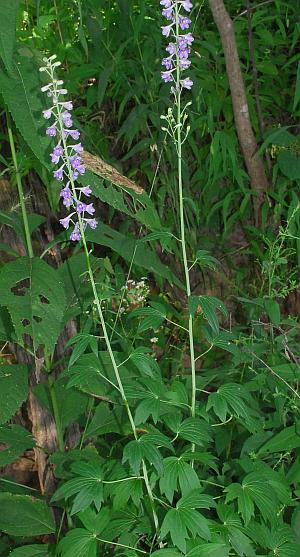Delphinium exaltatum Aiton
Tall Larkspur

Native
CC = 10
CW = 5
MOC = 2
SRank = S2
© SRTurner
Delphinium exaltatum AitonTall Larkspur | |
 |
Native CC = 10 CW = 5 MOC = 2 SRank = S2 |
© SRTurner |
|
Family - Ranunculaceae Habit - Perennial forb, the roots fibrous and usually relatively stout, not tuberous. Stems - Erect, to 1.5 m, glabrous, glaucous, green, fistulose, simple.
Leaves - Alternate, petiolate. Basal rosette absent at flowering; stem leaves 10-20 above the rosette. Petioles glabrous or with a few sparse hairs near the apex, to 15 cm long on the lowest leaves, reduced above. Leaf blades 4.5-9.5 cm long, 7.5-16.5 cm wide, usually with 3 main lobes, the deepest divisions ending within 4-12 mm of the blade base on most leaves (sometimes a minority of leaves cleft to the base or nearly so); ultimate leaf segments 7-17 mm wide, lanceolate to oblanceolate, angled or tapered to a sharply pointed tip, pubescent above and below, more so below. Veins of the blades impressed adaxially, expressed abaxially.
Inflorescence - Terminal indeterminate raceme, occasionally grouped into panicles, the axis sparsely to densely short-hairy; the flower stalks ascending, but generally angled away from the inflorescence axis, the lowermost stalks 1.0-2.5 cm long, the bracts subtending the flower stalks usually all undivided.
Flowers - Sepals pale to dark blue or purple to almost white, the lateral sepals 7-10 mm long, the spur 9-13 mm long, straight, but often somewhat upward-or downward-angled, occasionally bent downward near the tip. Corollas of 4 free petals, these with the body 3-5 mm long, white, the lower pair 2-lobed to above the midpoint, bearded on the inner surface near the notch. Stamens about 30, from below the carpels. Filaments white, strongly compressed in the basal half, nearly terete in the apical half, sparsely pubescent, curling in the apical half, 5-8 mm long. Anthers yellow when fresh, quickly drying to a chocolate-brown color, 1.2 mm long. Pollen whitish. Pistils 3. Ovaries densely antrorse appressed pubescent (the hairs white), ovoid in flower, 2.0-2.3 mm long in flower, unilocular, with 4-5 ovules. Styles white, glabrous, to 2 mm long.
Fruits - Follicles 7-12 mm long, erect, those developing from a given flower more or less parallel, finely short-hairy. Seeds 1.5-2.5 mm long, the outer surface finely wrinkled, brown to dark brown.
Flowering - July - August. Habitat - Rocky slopes in mesic upland forests, usually on dolomite substrate. Limestone or cherty limestone north and/or west-facing wooded slopes along the Current and Jack's Fork Rivers. Origin - Native to the U.S. Lookalikes - Vegetatively nearly identical to Aconitum uncinatum, which is also rare in Missouri. When flowering the two are easily distinguished. Other info. - This striking plant has currently only been found in two southern Missouri counties. Its total global distribution is limited to just a few states, roughly centered on Virginia. Where found, it can be locally abundant, however. This species is the tallest of the genus in Missouri and is definitely worthy of cultivation. It is distinguished from Missouri's other species of Delphinium by having glabrous, glaucous stems, numerous leaves on each stem, and relatively wide leaf lobes. Photographs taken at the Sunklands Conservation Area, Shannon County, MO., 7-21-04 (DETenaglia); also at Shaw Nature Reserve, Franklin County, MO, 7-18-2018 and 8-4-2021 (SRTurner). |